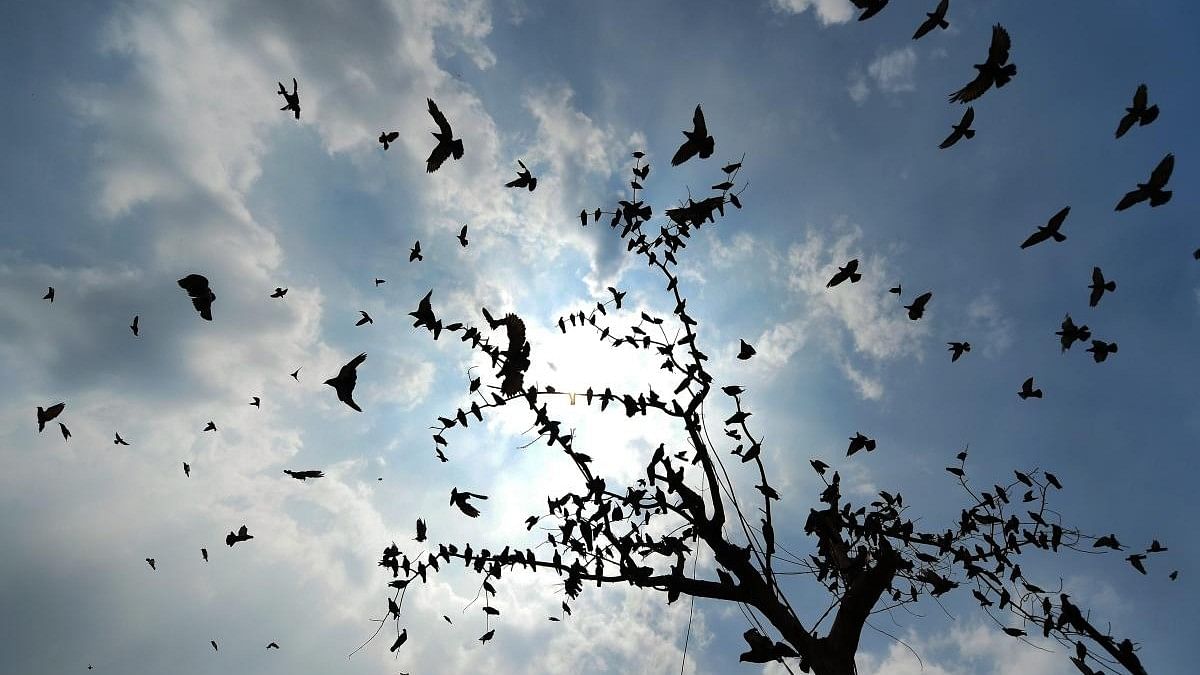
Image of birds flying.
Credit: PTI Photo
It happens every fall: The days grow colder, the nights grow longer, the birds grow restless and then they take flight. In North America alone, billions of birds fly south for the winter, sometimes in enormous undulating flocks. It is one of nature's great spectacles as well as an athletic feat: Some birds regularly migrate thousands of miles or stay aloft for days at a time.
And yet, for a large-scale, annual event, migration remains surprisingly mysterious. Scientists are still seeking answers to basic questions about the costs and benefits of these avian journeys and what it takes to survive them.
"How do you get a bird like a godwit that can fly over the entire Pacific Ocean?" said Christopher Guglielmo, a biologist at Western University in Ontario who studies the physiology of bird flight. "How do they have enough energy?"
And, perhaps more to the point of his own research, he added, "How do you study what's going on inside a bird?"
It is understandably difficult to monitor the internal workings of a wild bird while it is soaring thousands of feet in the air. So Guglielmo sends his avian test subjects on simulated journeys. At the Advanced Facility for Avian Research, he and his colleagues use a hypobaric wind tunnel, which functions, in essence, as a treadmill for airborne birds.
Scientists can send air through the main test chamber at varying speeds, up to about 40 mph. Not all birds take to the tunnel -- "about half of them will be good flyers," Guglielmo said -- but those that do can flap their wings for hours at a time while remaining, conveniently, in one place.
Researchers can adjust not only the wind speed inside the tunnel but also the temperature, humidity and air pressure to simulate different flying conditions and altitudes. They can study the physics of flight, mapping how air flows around the bodies of different birds, or focus on avian physiology: How does a bird's breathing change at higher altitudes? How does diet affect flight performance?
Answering these questions will help scientists grasp what birds are capable of and what their limits are. It could also help to predict how wide-scale environmental changes from pollution and global warming might affect the ability of birds to survive long-haul journeys.
In one current study, Guglielmo's team is examining Western sandpipers, small shorebirds that spend their summers breeding in the Arctic tundra of Alaska and Siberia. "The family of birds that they're from, of shorebirds, are considered the champion migrators of the bird world," Guglielmo said. In the fall, Western sandpipers travel down the Pacific Coast; some fly as far as South America, stopping to rest and refuel at bays and wetlands along the way.
The researchers are studying how much energy it takes for the sandpipers to fly at different speeds. The relationship is not a linear one. Hovering in one place requires a lot of energy, Guglielmo said, as does flying at top speed. Somewhere between those extremes is a bird's most energy-efficient speed, one that allows it to cover a lot of ground while burning relatively few calories.
Pinpointing this speed will help scientists determine how far the sandpipers can fly without refueling -- and what might happen if some of their critical migration stopover sites disappear. "If we lose this wetland and we develop this shoreline, can they skip over and go somewhere else?" Guglielmo said.
To measure how much energy the sandpipers expend while flying, the researchers analyze the chemical composition of the birds' breath. Just like humans, when birds use energy, they consume oxygen and produce carbon dioxide; the more energy a bird uses, the more carbon dioxide it exhales.
To measure a bird's carbon dioxide production while it is in flight requires outfitting it with a tiny respiratory mask. But that is a highly unnatural state that is likely to make flying even harder. "We try to use the least invasive methods that we can," Guglielmo said.
So before the researchers put each bird in the wind tunnel, they inject it with a small amount of carbon 13, a heavy form of carbon that is relatively easy for scientists to trace. (Carbon 13 is not radioactive and does not harm the birds.) The more energy the birds use while flying, the more carbon 13 they expel, in the form of carbon dioxide. Less then remains in their bodies and breath when they are removed from the wind tunnel.
The scientists are charting the birds' energy expenditures at both ground level and a simulated altitude of about 10,000 feet. A warming climate could prompt some birds to fly at higher altitudes, where the air is cooler but also thinner. Theoretical models suggest that the birds should have to work harder to fly in this thin air. "But we want to know how much harder," Guglielmo said, "so we have to measure it."